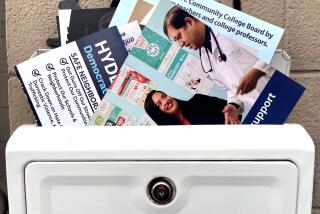Private Post : Lower Bulk Rates Help Independent Mail Firms Compete With the U.S. Postal Service
While most of Los Angeles is awakening, a squad of uniformed carriers is often found at an office in Paramount preparing the day’s mail deliveries.
They aren’t postal workers, and their satchels don’t include the letters that by law are the exclusive domain of the U.S. Postal Service. But carriers for Advertising Consultants Inc. are the sort of people increasingly in demand since the Postal Service implemented its largest bulk rate increase ever on April 3.
To the average resident, bulk mail is “junk mail”--those mass-distributed advertising brochures, credit card and charitable solicitations and invitations to buy almost anything that clog the mail box everyday. To the Post Office, bulk mail is material of less than 16 ounces per piece that is mailed under a special permit certifying that the sender has met certain Post Office requirements.
Those requirements include a minimum number of pieces in each mailing that have been sorted to some degree by the sender to save work for postal workers. Post Office bulk mail must also be carried by the sender to certain designated Post Offices for distribution.
The Post Office’s bulk mail rates increased an average of 25% (rates for non-profit organizations rose about 7%) at the same time that a first class stamp jumped to 25 cents from 22 cents. That means the cost of delivering 1,000 pieces to homes in Beverly Hills might cost the sender $165 to go through the Post Office, compared to $65 for ACI to deliver the material.
“Ordinarily, we would get four to six calls a week from new clients,” said ACI Chairman Benjamin B. Somers. “Since the increase, we have been getting 30, 40, 50 calls a week. They are people who are objecting to the postal rate increases.” Of course, a major reason that private distributors cost less is that they mostly use part-time workers and don’t have the high cost of the Postal Service’s unionized work force.
And, since the rate hike, private bulk mail distributors across the country have been loudly trumpeting their lower rates. “We haven’t raised our rates in several years and we don’t plan to,” ACI’s literature boasts.
Many Restrictions
The private distributors are generally limited by federal law to blanket deliveries of advertising circulars, product samples and other items to every household in an area. The circulars and brochures hanging in plastic bags from residential doorknobs are their deliveries.
They aren’t allowed to leave items in mailboxes. And under terms of the Postal Service’s monopoly on letter mail, they generally can’t deliver a piece of mail with an address on it. That even includes mail addressed to “occupant.”
Private distributors may deliver some addressed mail--but it’s mostly magazines and catalogues that are allowed into the private distribution system if they consist of at least 24 bound pages. Private distributors of such items, which the Postal Service classifies as second-class mail, sprang up shortly after the Postal Service became an independent governmental agency in 1971 and increased its rates for magazines and catalogues dramatically.
For a time, the Postal Service kept second-class rates competitive with the private concerns, said Phillip Miller, president of United Delivery Systems of Grand Rapids, Mich. Miller’s firm handles practically all of the privately distributed second-class publications, including Better Homes & Gardens, Good Housekeeping and some copies of Time magazine.
The latest postal rate hike, however, includes a second-class increase that will shift the advantage to private companies, said Robert Inhofe, a direct marketing consultant. “We are already seeing a huge new interest from second-class mailers,” he said.
Private distributors of magazines and other second-class mail are a small part of the industry. No one is quite sure how big the private bulk mail distribution system is because the companies tend to be local firms serving local areas and don’t report volumes to a central source.
However, it’s estimated that the 46 members of the Assn. of Private Postal Systems deliver to 25 million to 35 million households daily, according to association President Kenneth Boone, who is also president of Baltimore-based Direct Marketing Associates, a private bulk mailer.
There is widespread agreement that such distributors are increasingly sophisticated.
“The business has changed dramatically,” said John von Hecht, chairman of California Independent Postal System of Gardena, who has been in the business 20 years. In the early days, he said, it was common for distributors to hire anyone, including men loitering on downtown streets. California Independent, the nation’s largest private distributor, was created recently with the merger of Independent Postal Systems Inc. and California Postal Delivery of Inglewood, Hecht said. The combined company delivers about 5 million circulars a week, Hecht said.
Private distributors use some of the same tools as the Postal Service, including computerized mapping of delivery routes and detailed pre-sorting, he said.
Some even use the Postal Service. “My company is one which utilizes the best distribution system for the client,” said Boone, adding that his company provides pre-sorting and preparation services for items going through the Post Office. “The pieces that are hand-delivered are those that are very time-critical. We deliver a lot of (free community newspapers) that go to press on Wednesday night and must be at residences on Thursday mornings (to promote weekend sales),” he said.
In addition to price, the private bulk mail distributors’ most effective selling point is guaranteed delivery within a specified time, ACI’s Somers said--something the Postal Service can’t do. Independent auditors available to clients hold the distributors to their promises.
Permission Sought
Private distributors also claim that their delivery is more effective for bulk mail. For example, Somers said postal workers often leave magazines, catalogues or advertising brochures addressed to all residents of apartment and condominium buildings in the lobby because the items are often too big for the mailboxes. Most residents will ignore the bundle, he said.
ACI carriers seek permission to go inside buildings and hang items on the door knob of each unit, he said, thus assuring that they will be noticed, he said.
Despite the private distributors’ ability to pinpoint target audiences for clients, their inability to deliver mail to a specific person limits their usefulness to many direct marketers who use mailing lists to target very specific groups. Those are the kind of marketers who might, for example, want to reach two-income couples making more than $150,000 a year who recently had a baby.
Direct marketers may challenge the Postal Service monopoly on letter mail, Inhofe said. A consultant to the 3,000-member Direct Marketing Assn., Inhofe said members want to deliver some mail destined for specific individuals at specific addresses without actually putting the labels on the items. He said the association has presented a specific proposal to the Postal Service, but declined to reveal its contents until the Postal Service officially responds.
The initial reaction? “We didn’t get thrown out,” Inhofe said, explaining that in the past, the Postal Services’ position has been that such activity would be illegal, because the “address exists in the mind of the carrier even if it isn’t physically addressed. We don’t think that will stand up in court.”
Some industry sources said some private distributors are already quietly doing what Inhofe described, but on a very small scale. They have created computer codes for carriers who deliver to specific individuals and addresses based on the codes, the sources said.
More organized challenges to the Postal Service’s monopoly wouldn’t be surprising given increasing rates, Miller said. “You will see some banding together to take away that ridiculous definition of what is a letter.”
More to Read
Sign up for Essential California
The most important California stories and recommendations in your inbox every morning.
You may occasionally receive promotional content from the Los Angeles Times.










